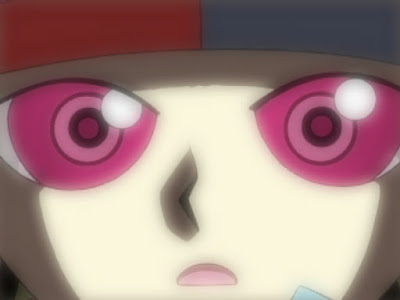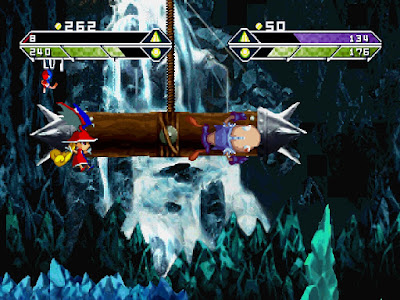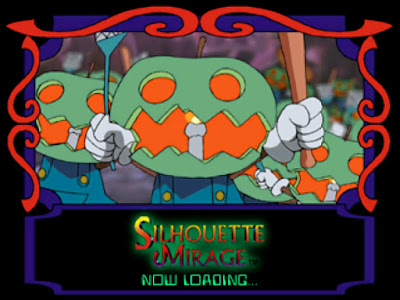Some video game titles just scream 'Japanese release' to me, and Silhouette Mirage is one of them. You just don't get titles like that from western developers; titles that don't quite sound right and give few hints as to what's going on with the game itself, if any.
But a game is much much more than its title, and this one will have us platform run and gunning our way around the place, shooting things in particular ways. What on Earth do I mean by that?
Frustrations
Got all that? No? Neither did I. The intro movie is so quick and flashy that even jabbing the screenshot shortcut in time was a challenge, let alone trying to follow along with what's going on. I think there are at least two bad guys, which we as a short blonde thing surrounded by weird animals will no doubt deal with at some point. Beyond that, I've not got a clue what this game is about yet, but let's press start and find out.
I said 'let's press...' Nope. No working Start button. Ok. Let's troubleshoot. I'm emulating the PlayStation version here, which came out a few years after the Sega Saturn original, so what quirks exist here I wonder...
Turns out that Silhouette Mirage is looking for an analogue PlayStation controller set to the right mode, either analogue or digital, I can't remember. Remember that button on the old controllers with a red light underneath? That's the important button here, and it needs toggling. Well, it needs assigning to a button first, and then it needs toggling, and after a restart, we're in.
Fun Times
Thankfully for me, Silhouette Mirage begins with a clear and fairly thorough tutorial that takes us through all kinds of moves and, importantly, key concepts. The whole game is based around a key concept of being in the right kind of state, I suppose you could say, when facing the right kind of enemy.
Enemies are split into two types, Silhouette and Mirage, and you have those two states to. By default, when you're moving right, you're in the Mirage state, and when moving left, you're in the Silhouette state, and they'll have different effects on different enemy types.
Already, you can see the kind of puzzle nature to this platformer, but it's not as limited as you might think based on that global rule if you will. There are moves that allow you to dash through enemies or grab them and chuck them to a more useful side of the screen for you to deal with, but there are also opportunities for you to switch your states up, reversing them from their default directions.
Luckily, there's only really a grab button and a shoot button for you to worry about. The movement includes dashes and crouching and crawling, and lord knows what else, but it's all fluid enough for you to not get too bogged down in controlling yourself in order to put yourself into a controlling position on the screen for any given situation.
So what are those situations?
Well, this was unexpected. These... things... are mutated in some fashion, and are our foes until we fix the planet. For the time being, if we attack them from left to right, we weaken them, rather than outright kill them, but the reverse is true if we attack right to left, and if we want to beat some lunch money out of them, we can literally grab and pummel the problem out of them too.
To prove the point about there being plenty of ways to deal with opponents, I forgot that you can block their incoming shots, and by block, I really mean return. Shots bounced back will often deal damage, perhaps more damage than your own shots, so it's worth checking out.
After some forward progress, I get cutscened through the floor by a mech piloted by those weird things (seriously, what are they?) and we're into the second little introduction level, which replaces Mirage enemies with Silhouette enemies.
The deal is the same but, for the time being, the strategy is reversed a little. Attacks from the left to the right are good, which is handy if the level broadly speaking goes to the right.
It doesn't.
Levels have some verticality to them, and you'll be flying around the place (or literally dashing up and along the walls) in order to navigate, along with your double jump.
Eventually, after trying out as many moves from the tutorial as I could remember, I found myself at a boss fight, involving some kind of punk fish.
He does have a few voice lines, which have quite the accent, and sounds much better than the voice of whomever we're playing as. You'll be hearing her almost joyfully shout out all her moves. Are you using your reflector shield? "Reflector!". Are you jumping around the screen? "Hup! Hup!". Have you grabbed an enemy and punched the money out of them? "Bam bam bam bam!"
That might get old fast, so hopefully, the underlying music is worth a listen. It's that or the sound of your brain grinding to a halt trying to remember which angle of attack will work well on this enemy type at this point in time.
With the help of my fishy friend getting sort of stuck on the sloping geometry, and thus throwing all of his shots wildly off target, I was able to dispatch him into the background and continue along my merry way. I don't know who he is or what he wanted though. He seems to have had no importance to the scene.
I was then blasted out of my victory pose by another mech and killed. Oh well. There's plenty of retry's left.
Final Word
That's pretty much where I left Silhouette Mirage, after a very brief initial run. After defeating that mech you get blasted back up to the surface world, and that's when I called it a day. I'm just not getting the time these days, and so have to resort to very little knowledge when coming to a conclusion about these games.
From reading about the game, I thought I probably wouldn't like it too much. The idea of needing to face the enemy from the right direction and using the right technique to defeat them sounded like too much of a challenge in a two-dimensional environment, and if not a challenge, then too limited a gimmick to want to play for very long.
Since playing, however, I know that this game goes much deeper than that, with all the moves and abilities you've got available to you, that enable you to dance around the battlefield in order to make sure you can do what you need to do.
Its cartoony nature may put people off - it's not too off-putting to me like Bangai-o was - but if you think of it as an arcade shooter, then you might find yourself in the right frame of mind to approach it. It's got platforming, but it seems to not be as important a focus as the combat, which is as much of a puzzle as it is to navigate a ship through bullet hell, while it attacks another ship with the right weapon.
If I were to find the time to pick up Silhouette Mirage again, I'd probably enjoy playing it for a little while, but I have my doubts as to how well it'll grab my attention for the long haul. I don't know much about what's going on, and the intro movie still doesn't make any sense, but that'll come in time I'm sure.
Until that time, all I can say is that it's worth a look if only to see how those combat concepts work.
Fun Facts
Most of the options available to players are actually locked until you beat the game, making the English release much harder than the Japanese original.
Silhouette Mirage, developed by Treasure, first released in 1997.
Version played: PlayStation, 2000, via emulation.




























































